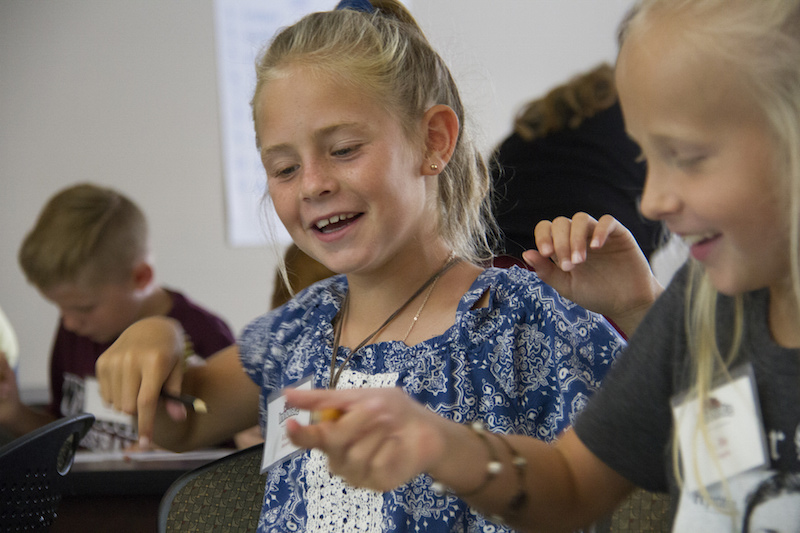by Erika Solberg
Third, fourth, and fifth graders are busy solving problems and inventing new worlds at Camp Innovate this week. The multi-discipline camp allows every student to work with the theme of innovation in five areas: Art, Math, Language Arts, Science, and Clowning. This past Tuesday, scenes of creative and critical thinking were everywhere.
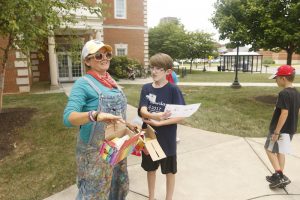 In Art, teacher Andee Rudloff gave her class the task of creating a logo for their own businesses. She guided them through steps to help them figure out what they wanted to communicate: list five friendly words to describe your business, design a simple icon for each word, and group together colors that express what your business does. Finally, using the best of those ideas, create a logo that “pulls the meaning of your business together — even if I’m a three-year-old who doesn’t read, I should be able to look at your symbol and get what your business is.”
In Art, teacher Andee Rudloff gave her class the task of creating a logo for their own businesses. She guided them through steps to help them figure out what they wanted to communicate: list five friendly words to describe your business, design a simple icon for each word, and group together colors that express what your business does. Finally, using the best of those ideas, create a logo that “pulls the meaning of your business together — even if I’m a three-year-old who doesn’t read, I should be able to look at your symbol and get what your business is.”
While the students worked, Andee was full of enthusiasm and questions, working her way around the room and saying things like, “That’s so cool!” “Awesome!” “That’s pretty bold!” “A unicorn-shaped head? I love it!” “Nice!” “Your wheels are turning!”
Sena Er of Bowling Green caught Andee’s energy. When asked to explain her business, she said, “My business is called My Hoverlife, and it’s a line of all things that hover like boards, bikes, and cars — all solar powered so they’re environmentally friendly — and bright and colorful to show people a whole new way of being.”
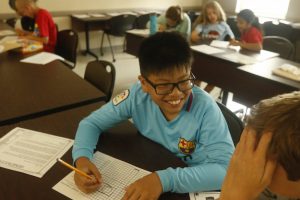 In Math, students are spending the week designing their own cities. The first step was to choose a set of geometric concepts to include such as a trapezoid, a scalene triangle, or certain angles, and to select features to include in the city like a pharmacy, park, or school. On Tuesday, the students mapped out their plan on graph paper.
In Math, students are spending the week designing their own cities. The first step was to choose a set of geometric concepts to include such as a trapezoid, a scalene triangle, or certain angles, and to select features to include in the city like a pharmacy, park, or school. On Tuesday, the students mapped out their plan on graph paper.
“We can curve this one and make this one straight. That’s a radius,” Natalie Cox of Rockfield said to her partner, Anne Howard Waugh of Alvaton.
John Gardner Brown of Bowling Green described his sky scraper this way: “I put a parking garage on it, but then I erased it and moved it to a different corner of the city. The building has a needle on top of it. I have a square and a right triangle so far.”
Later in the week, teacher Nikki Nicholas explained, students will cut out their two-dimensional maps and match up the roads so each city connects. Then they will take cardstock, fold it into three-dimensional shapes, decorate them, and place them on their city plans, transforming the room into a geometric metropolis.
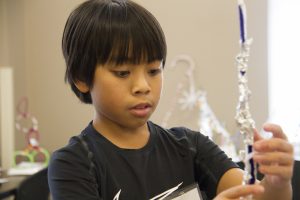 If you visited the Language Arts class on Tuesday, you would have heard many plans for innovations and inventions. First, Mary Evans read to the class The Boy Who Harnessed the Wind, written by William Kamkwamba and Bryan Mealer and illustrated by Elizabeth Zunon. The story tells of a teenaged boy in Malawi who constructs a windmill for his village using scavenged material in order to provide electricity after a drought. They also watched a YouTube video of a clip from The Ellen Show of kid inventors and discussed the difference between inventors and innovators.
If you visited the Language Arts class on Tuesday, you would have heard many plans for innovations and inventions. First, Mary Evans read to the class The Boy Who Harnessed the Wind, written by William Kamkwamba and Bryan Mealer and illustrated by Elizabeth Zunon. The story tells of a teenaged boy in Malawi who constructs a windmill for his village using scavenged material in order to provide electricity after a drought. They also watched a YouTube video of a clip from The Ellen Show of kid inventors and discussed the difference between inventors and innovators.
Then she asked them to think about a problem in their lives or communities that they wanted to solve. After discussing their ideas in small groups, each student individually wrote and drew about the innovation or invention that would help solve the problem. Ideas were varied and marvelous:
- Molly Miller of Island devised a student-cam with GPS that coordinates with a teacher app so that on a field trips, students “can have more fun and can go farther” without teachers having to worry about anyone getting lost.
- Jairon Keo of Bowling Green created a thinking cap that makes you think ten times better.
- McKinley Wright of Bowling Green created a cleaning machine: “It’s a tripod, and after you clean your room, it scans the room so it knows where everything goes. When your room gets messy again, it can put everything away for you.”
- Tony Ta of Owensboro likes laptops, so he innovated the standard design by adding facial and fingerprint recognition and making it lighter.
- Neha Reddy of Bowling Green wanted to reduce the problem of tripping and falling, so she designed a shoe that alerts wearers when an obstacle appears.
 In Clowning, Tuesday was juggling day. Using scarves, teacher Nick Wilkins explained the basic concept: “Juggling is very easy — we all can juggle — the best way to learn is to use a rectangle. The bottom is at your waist, and the top is at eye level. You don’t want to look at your hands because they’re not going to go anywhere. We’ll start with scarves — two in one hand and one in the other. Throw one of the two diagonally to the corner. I throw with a claw — I flick my wrist backwards.” He also showed them the basics of beanbag balls and different juggling patterns like the cascade and the reverse cascade.
In Clowning, Tuesday was juggling day. Using scarves, teacher Nick Wilkins explained the basic concept: “Juggling is very easy — we all can juggle — the best way to learn is to use a rectangle. The bottom is at your waist, and the top is at eye level. You don’t want to look at your hands because they’re not going to go anywhere. We’ll start with scarves — two in one hand and one in the other. Throw one of the two diagonally to the corner. I throw with a claw — I flick my wrist backwards.” He also showed them the basics of beanbag balls and different juggling patterns like the cascade and the reverse cascade.
Soon it was time for the students to try for themselves, and they rushed to the front of the room. Some chose scarves, others beanbags. Some threw themselves into the hardest maneuvers, and others proceeded with great caution.
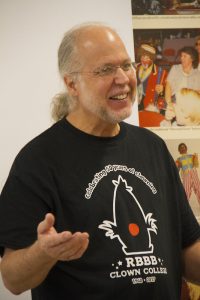 No matter their style, Nick offered gentle corrections and big encouragement: “Remember to throw to the corners,” he reminded them. He also announced, “We have jugglers in here! If you tell yourself you can do it, then you can do it!” Spotting Ethan Goodin of Bowling Green having some trouble, he worked with him one-on-one.
No matter their style, Nick offered gentle corrections and big encouragement: “Remember to throw to the corners,” he reminded them. He also announced, “We have jugglers in here! If you tell yourself you can do it, then you can do it!” Spotting Ethan Goodin of Bowling Green having some trouble, he worked with him one-on-one.
This year’s science class has a Harry Potter theme. Teacher Allison Bemiss has decorated the room with such Hogwarts-ian objects as a sign for The Three Broomsticks, a stuffed owl in a cage, electric candlesticks, a Fantastic Beast suitcase, black tablecloths, house banners, and a witch’s hat. She has also hung a vocabulary list on the board which on Tueday included “chemical reaction,” “polymer,” “solution,” and “polysaccharide.”
For this lesson, she introduced the concept of light by asking the students what cool thing Harry had to sneak around with, and everyone knew the answer: “An invisibility cloak!” She then explained that they would work with light to make things appear and disappear, saying that as always she would be listening for the students to say the scientific phrases of “I wonder …” and “I notice ….”
 Wearing lab coats, pairs of students each placed a penny under a plastic cup and put a white Styrofoam bowl on top of the cup. When Allison asked if they could look through the side of the cup and see the penny, they all agreed they could.
Wearing lab coats, pairs of students each placed a penny under a plastic cup and put a white Styrofoam bowl on top of the cup. When Allison asked if they could look through the side of the cup and see the penny, they all agreed they could.
Next, they filled up the cup a little over halfway with water and put the bowl back on top. Now when they looked through the side, the coin seemed to have disappeared — it was invisible!
The subsequent discussion involved a lot of observations and hypotheses.
Mason Lovell of Greenville suggested, “The light reflection is going up. If you put more water in the cup, the coin would look taller.”
“The light bent, so you can’t see it. Water is different from air when light travels through it,” added Alper Er of Bowling Green.
Aiden Garrie of Russellville suggested that “the water is blocking out the vison. The light is refracting.”
“Would you see the coin if it were in the cup rather than under it?” Allison asked. Some in the class thought yes, some thought no, and some were not sure. Allison then took out a tiny broomstick and placed it in a cup of water.
“It looks really big in the water,” said Grace Fridy of Louisville. “It looks like it’s bent.”
No matter where you went in camp on Tuesday, the learning was, indeed, magical.

